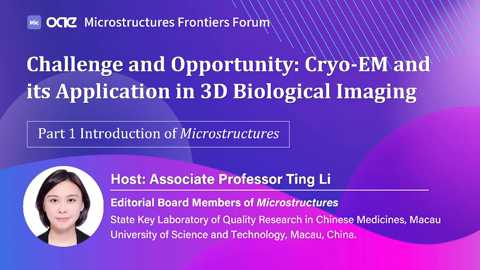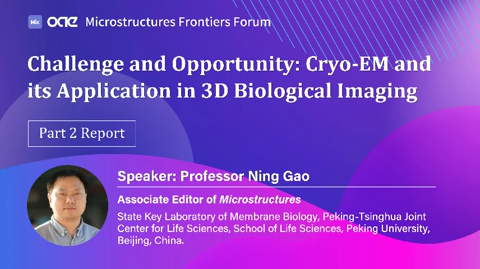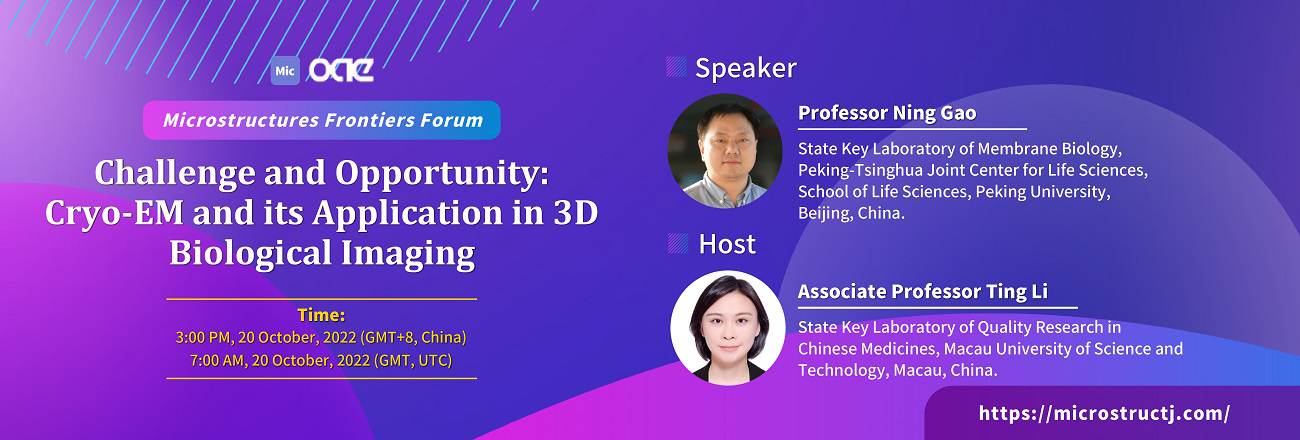Contents
Chair
Associate Professor Ting Li
Editorial Board Members of Microstructures
State Key Laboratory of Quality Research in Chinese Medicines, Macau University of Science and Technology, Macau, China.
State Key Laboratory of Quality Research in Chinese Medicines, Macau University of Science and Technology, Macau, China.
Speaker
Professor Ning Gao
State Key Laboratory of Membrane Biology, Peking-Tsinghua Joint Center for Life Sciences, School of Life Sciences, Peking University, Beijing, China.
Ning Gao, Professor of Biochemistry and Biophysics, Peking University. Dr. Gao received his Ph.D. in Biomedical Sciences from the State University of New York at Albany in 2006. He worked in Tsinghua University from 2008-2017. Prof. Gao is currently a Professor in the School of Life Sciences, PKU. He has been the Ministry of Education Cheung Kong Scholars Program Distinguished Professor since 2018. He was supported by the Outstanding Young Scholar program of the National Science Foundation of China in 2017, and has received a few national scientific research awards, such as the C.C. Tan Award in Life Sciences. The general research interest of his laboratory is to understand mechanistic details of cellular molecular machines, using cryo-EM technique as a major tool. In the past a few years, he have primarily focused on ribosome biogenesis in both prokaryotic and eukaryotic systems, towards answers to a few fundamental questions, such as “how the ribosome is made in the cell”, and “how ribosome biogenesis, or the translation capacity of a cell is regulated by various well-characterized growth-control pathways”. Meantime, part of his research effort is also devoted to research collaborations on structural determination of nucleic-acid/protein complexes, such as DNA replication machinery.
Introduction
With recent breakthroughs of image processing algorithms and image recording devices, cryo-EM is going through a revolutionary phase, overtaking X-ray crystallography as a major tool for high-resolution 3D biological imaging. In addition to its ability of 3D visualization of biological macromolecule assemblies at atomic resolution, cryo-EM is well suited for studying the dynamics of large molecular machines that are oscillating between compositional and conformational states in the cells. I will use a few biological applications to illustrate the development of cryo-EM over the past a few decades. I will focus on the current limitations in the workflow of sample preparation and data processing, and discuss the urgent needs of improving the method from sample-freezing techniques to imaging classification algorithms.
Moments
Presentation

Challenge and Opportunity: Cryo-EM and its Application in 3D Biological Imaging: Part 1 Introduction of Microstructures
NaN

Challenge and Opportunity: Cryo-EM and its Application in 3D Biological Imaging:Part 2 Report
NaN

Challenge and Opportunity: Cryo-EM and its Application in 3D Biological Imaging:Part 3 Discussion
NaN






